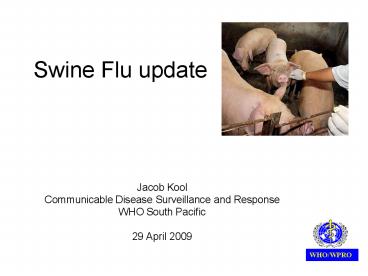Swine Flu update - PowerPoint PPT Presentation
1 / 16
Title:
Swine Flu update
Description:
Swine Flu update. Jacob Kool. Communicable Disease Surveillance and Response. WHO South Pacific ... 2000 suspected cases, 152 deaths thought linked to swine flu ... – PowerPoint PPT presentation
Number of Views:186
Avg rating:3.0/5.0
Title: Swine Flu update
1
Swine Flu update
- Jacob Kool
- Communicable Disease Surveillance and Response
- WHO South Pacific
- 29 April 2009
2
Influenza
- Symptoms
- Sudden onset of high fever ( 38 C)
- Cough and/or sore throat
- Runny nose, other respiratory symptoms
- Body aches, headache, fatigue.
- More severe influenza
- Difficulty breathing, death
- Transmission
- touching, shaking hands, or kissing
- coughing, sneezing, or talking, at close distance
(lt 2 meters)
3
Swine Influenza A H1N1A new virus
- Reassortment - four different genes
- North America swine
- Asia/Europe swine
- Human influenza
- Avian (Non H5)
- Unique combination that has never been seen
before - Human to human transmission confirmed
- Level of immunity in general community Unknown
- Effectiveness of seasonal influenza vaccine
Unknown - Antiviral drugs
- Sensitive to Tamiflu and Relenza
- Resistant to amantadines
4
Latest update (29/4/09 AM)
- The outbreak started in Mexico in February or
March - 26 confirmed cases, 5 died
- gt2000 suspected cases, 152 deaths thought linked
to swine flu - Many severe cases among young adults
- Outbreak may be levelling off
- Confirmed cases in other countries
- USA 67
- Canada 6
- Spain 1
- New Zealand 3
- UK 2
- Israel (2)
- Not yet in the Pacific?
- All cases outside of Mexico are mild no deaths
- WHOs Dr Fukuda this pandemic may be mild
5
Google map updated 29/4
6
Clinical Presentation (Mexico)
- Range of symptoms very mild to severe acute
respiratory symptoms - Vomiting and diarrhoea in some cases
- Incubation period up to 7 days
- Fatal cases ill for 6 days, then deteriorate
7
Why is the illness more severe in Mexico?
- No explanation yet
- Some theories
- Inaccurate information? Biased by panic?
- Are many mild cases missed?
- Did the virus change after it spread to other
countries? - Multiple different viruses?
8
Control measures in Mexico
- Closed schools, churches, bars, restaurants, etc.
- People advised to stay home
- Ill people advised to quickly get medical
attention - Handing out of face masks in public places
- Intensive surveillance and case investigation
9
WHO health emergency
- Public Health Emergency of International
Concern under the International Health
Regulations - Pandemic alert -gt phase 4
- All countries must intensify their surveillance
and report to WHO any suspicious cases or
clusters - Surveillance guidelines have been disseminated
10
Overview of WHO Pandemic Alert Phases
11
WHO pandemic alert phases
- Phase 4 is characterized by verified
human-to-human transmission of a new virus,
causing community-level outbreaks. - Emphasis on surveillance and rapid containment
- Phase 5 is characterized by human-to-human spread
of the virus into at least two countries in one
WHO region. - Focus on (preparing) mitigation efforts
- Phase 6, pandemic phase outbreaks in at least
one other country in a different WHO region in
addition to the criteria in Phase 5. - Focus on mitigation and continuation of essential
services
12
Pandemic Response
- Antiviral drugs
- Vaccines, etc
- Medical care, PPE
Medical interventions
Non-Medical interventions
- Personal hygiene
- Travel restriction
- Quarantine
- Social distancing
- Risk Communication
Public Health Measures
- Security
- Food water supply
- Power supply
- Transportation
- Telecommunication
- other essential services
Social Services (keep a society running)
13
What needs to be done - NOW
- Intensify surveillance
- Report to WHO any cases or unusual outbreaks
- Share samples
- Inform clinicians
- Inform travellers
- screening was not effective in the past
- Inform the public
14
When cases are confirmed
- Inform the public, medical staff
- How to protect themselves, seek medical care
- Social distancing
- School, church closures
- No public gatherings
- Stay home
15
Advice to general public
- Wash hands frequently with soap and avoid
touching your face. - Cover your mouth or nose when coughing or
sneezing - Avoid close contact with obviously sick people
- Stay at home if you are unwell
- See your doctor if you have flu symptoms
16
Border control International travel
- Health information and advice to international
travellers - Protect yourself
- Seek health care if you get ill
- Countries may consider entry screening
- Travel restrictions, border closures not
recommended - But islands may benefit from temporary travel ban































